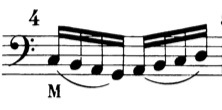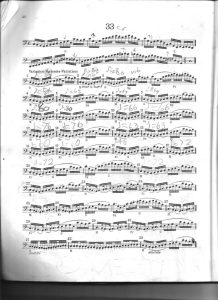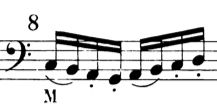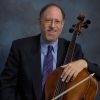
The Joy of Feuillard – A Sequential Approach to Teaching Bow Technique (Part 13 – Feuillard No. 33 – Variations #4-9)
Robert Jesselson
In today’s blog we will continue Feuillard No. 33 with the Variations #4-9, dealing with legato playing, staccato strokes, and bow distribution.
Variation #4 and #5:


Notice in the video that Iestyn knows the tempo of these variations when I asked him, because he has written in the tempos that he thinks are good as he works on them at home:

It is important for the students to be able to imagine their tempos before playing them in the lesson. Having practiced them well at home, they should be able to predict the tempos pretty closely. If they can’t then it is a sign that they are not using the metronome in their practicing. Although rhythm is one of the most basic music elements, teachers often forget to stress the importance of developing good rhythmical skills. These concepts are often ignored or forgotten while focusing on other elements of playing: intonation, tone color, technique, etc. Developing good skills of rhythm, pulse, tempo, meter, timing, as well as related concepts such as keeping a steady tempo, ritardando, accelerando or rubato are fundamental for a good musician.
In Variation #5 Iestyn showed that he had made good progress in using the full bow, compared to the difficulty he had with that in a similar variation (#3) earlier. By terracing the various technical issues in Feuillard, students can conquer a particular problem in one variation and then move on to deal with the next issue in another variation.
Another issue that I like to address in Feuillard No.33 is the height of the left elbow. Even though we are working on right hand problems in these variations, it is also a great way to address the left hand issues (intonation, vibrato, arm height, etc) since the students are repeating the same notes so many times. In this case I worked with Iestyn on the left arm height:
Many students get in the habit of playing across the strings without using the support of the arm. That means they often create “kinks” in the wrist, which causes tension in the hand and prevents people from moving the fingers fast. I will address the “twist” motion mentioned here in much more detail when we get to Feuillard No. 35 and No. 36. But my goal here is to get Iestyn to be aware of the basic height of the arm on the different strings.
Variations #6 and #7:


These variations continue with legato playing and bow distribution. Legato playing requires maintaining the weight on the bow, without re-articulating or pulsing, and with no portatos in the stroke. This is particularly difficult with string crossings, where we need to think like pianists. Because the piano is a percussive instrument, with a hammer striking the strings, it is impossible to truly play legato. However pianists give the illusion of legato by slightly overlapping the notes. Like a magic trick, it gives the impression of a true legato. When cellists play string crossings in legato, we need to similarly overlap the two notes to give the illusion of the legato that we can play more easily on one string.
I had to remind Iestyn about what we had worked on earlier with the left arm. Learning and absorbing new technical information takes several repetitions. As a teacher I have to be like a dog with a bone: not letting go! I have to constantly remind the students about whatever I am trying to get them to make as habits, until just a visual cue might be enough. Eventually, if I am “stubborn” enough, they will be doing what they need to do without reminders. I guess teachers have to have a bit of a “control freak” personality – otherwise the students tend not to do what we are trying to get them to do.
Variations #8 and #9:


These variations are similar to the earlier pairs (#4 & 5, and #6 & 7). But now I needed to talk with Iestyn again about his bow angle in Variation #9. Here I worked with him on the concept of “proprioception” (awareness of where the arm is in space), which seemed to click with him this time:
As I mentioned before, in these blogs I am rarely showing the full “performance” of each variation. However, in the lessons the students do play the variations in their entirety. This is important because they are not only working on the specific details of each variation. They are also working on endurance, the ability to concentrate, and getting used to “performing” without stopping. Yes, I hear these variations all day in lessons from lots of different students. Maybe I am nuts, but I actually enjoy hearing them, and don’t get bored. Every student has a different sound, a different personality, and different problems or issues to solve in their playing – so it is always interesting!
Next Monday’s blog will continue work with staccato bowings and bow distribution.
*If you have questions or comments about The Joy of Feuillard, Dr. Robert Jesselson can be reached directly at rjesselson@mozart.sc.edu.
Subjects: Repertoire, Technique
